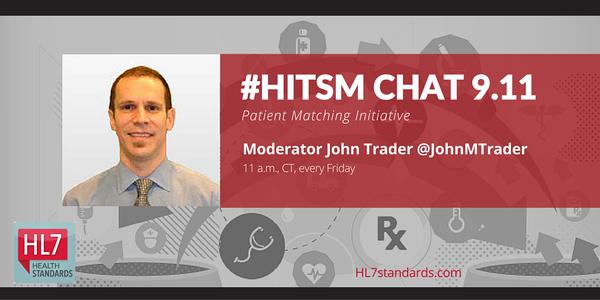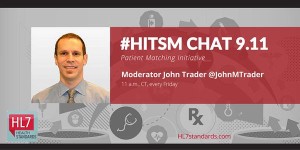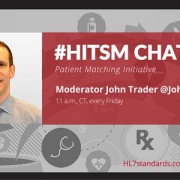#HITsm Tweetchat Highlights Progress, Obstacles for Patient Identification in Healthcare


Healthcare professionals from around the world discussed the dilemma of achieving accurate patient identification in healthcare during the 09.11.15 #HITsm tweetchat. (Photo courtesy of HL7 Standards)
We had the honor of hosting the weekly #HITsm Twitterchat this past Friday centered on the topic of patient identification in healthcare. For those not aware of the #HITsm weekly chat, the HL7 Standards Web site deftly describes it as:
“…#HITsm is an acronym for “healthcare IT social media” and we focus on current topics that are influencing healthcare technology, health IT, and the use of social media in healthcare.” (courtesy of: http://www.hl7standards.com/hitsm-chat/)
The chat demographic spans a wide range of healthcare professionals — vendors, doctors, patients, industry experts, and even national professional healthcare organizations — all coalescing for one hour each week to discuss a wide range of topics related to health IT.
Considering the importance of establishing accurate patient identification in healthcare and it’s ripple effect to many other aspects of care delivery, interoperability, accountability, and improving individual and population health, we selected this as a topic for the weekly discussion. Included in the discussion was an evaluation and assessment of the College of Healthcare Information Management Executives’ (CHIME) national patient identity challenge to determine if it will actually produce a solution that will eradicate the burdens of matching patient data and bring us closer to establishing higher data integrity, reducing medical errors, and improving care.
Topics for the chat included:
1. Establishing a national patient identifier continues to be a hot debate – will it ever materialize? Are there tangible benefits to a national patient identifier?
2. Will @CIOCHIME’s national patient ID challenge eradicate the burdens of matching patient data and bring us closer to establishing higher data integrity, reducing medical errors, and improving care?
3. Will true healthcare interoperability ever be realized in the absence of fixing the problem of inaccurate patientID?
4. Do patients now have an inherently larger role to ensure the accuracy of their medical records?
5. Does the explosion of mobile devices, telehealth, & mhealth tools raise the urgency level for healthcare providers to implement stronger patient ID technology?
6. What new patient identification technologies show promise to help improve patient matching and interoperability?
Responses, comments, and opinions to these topics were insightful and intelligent. Here is a list of select responses and feedback to some of the topics:
Topic 1: Establishing a national patient identifier continues to be a hot debate – will it ever materialize? Are there tangible benefits to a national patient identifier?
T1: Problem is the lack of a single patient identifier via a Master Patient Index (MPI) for use across the American healthcare system #HITsm
— Clinicspectrum (@ClinicSpectrum) September 11, 2015
#HITsm T1: Having a working national patient identifier would save many millions by streamlining data mining and related analyses. NPI any1?
— Gus Gilbertson (@gusgilbertson) September 11, 2015
Will it materialize? Not comprehensively, no. #US population too fluid, political environment not supportive. Beneficial? YES. #HITsm
— Mandi Bishop (@MandiBPro) September 11, 2015
T1 I hope so, but fear any pt identifier would have severe headwind from conspiracy nuts, anti-goverment groups, and lazy politicians #hitsm
— Matthew Loxton (@mloxton) September 11, 2015
T1: My opinion has always been that a national patient identifier should have been a prerequisite to #interoperability #hitsm
— John Trader (@JohnMTrader) September 11, 2015
#hitsm T1: there is definitely benefit to #NPID but getting it to materialize will take + effort, time, and resources. Too many variances.
— Erin Head (@ErinHead_HIM) September 11, 2015
T1 many medical mistakes result from ineffective methods of correctly identifying a patient, tying them to bed, condition, treatment #hitsm
— Matthew Loxton (@mloxton) September 11, 2015
T1 @CIOCHIME supports the requirements of coordinated, accountable, #patientcentric care. http://t.co/wWfnKNjBoX #HITsm
— Linda Stotsky (@EMRAnswers) September 11, 2015
Topic 2: Will @CIOCHIME’s national patient ID challenge eradicate the burdens of matching patient data and bring us closer to establishing higher data integrity, reducing medical errors, and improving care?
T2 #aging populations require a way to connect /coordinate care across multiple LOCs. If no caregiver, this becomes impossible #HITsm
— Linda Stotsky (@EMRAnswers) September 11, 2015
T2: Ensuring patient identification means avoiding financial loss and accreditation – and keeping patients safe #HITsm
— Clinicspectrum (@ClinicSpectrum) September 11, 2015
T2. #HITsm– It’s all about greater data integrity, reducing medical errors, and improving care. national #patient identifiers step n 2 solve
— Linda Stotsky (@EMRAnswers) September 11, 2015
T2: HIEs would greatly benefit from a National MPI. Sharing and Analytics would be so much easier if there was better matching. #HITsm
— clntryan (@clntryan) September 11, 2015
T2. “ID technology” is not the issue, the issue is matching the data with the individual (if they so desire) across multiple systems #hitsm
— Leonard Kish (@leonardkish) September 11, 2015
T2. In other words, people’s data needs a home that follows them (or at leas access follows them) through strong authentication. #hitsm
— Leonard Kish (@leonardkish) September 11, 2015
T2: The best it will do is bring more awareness to the challenges of patient identification. #HITsm
— EMR, EHR and HIT (@ehrandhit) September 11, 2015
I applaud @CIOCHIME efforts on this topic – and they continue to bring pressure where it’s needed – D.C. #hitsm
— Dan Munro (@danmunro) September 11, 2015
Kudos to @CIOCHIME for trying to make something happen. Good luck with the Challenge. #HITsm
— robmacmillan (@robmacmillan) September 11, 2015
Topic 3: Will true healthcare #interoperability ever be realized in the absence of fixing the problem of inaccurate #patientID?
T3 I cannot imagine how. If we cannot positively ID the pt, how will we avoid interop issues, and not kill patients? #hitsm
— Matthew Loxton (@mloxton) September 11, 2015
T3: Universal pt ID would #disrupt #healthcare making it about how #patients interact when need care vs ownership by hospitals #hitsm
— CancerGeek (@CancerGeek) September 11, 2015
T3: A #MyIDealPtExp would mean I have a universal ID that allows my records/images to be accessible by where/whom I seek care from #hitsm
— CancerGeek (@CancerGeek) September 11, 2015
T3: Current Algorithm for an MPI right now would be much faster if there was a NPID. #HITsm
— clntryan (@clntryan) September 11, 2015
T3: Many HIEs have adopted a UPI approach to solve patient matching problems, AHIMA article http://t.co/AYIMnLnqVI #HITsm
— CHIME (@CIOCHIME) September 11, 2015
T3: Universal pt ID would #disrupt #healthcare making it about how #patients interact when need care vs ownership by hospitals #hitsm
— CancerGeek (@CancerGeek) September 11, 2015
T3: Semantic interop will never exist in current system – NPI or no. We can do a good job at regional #HIE if we decide to w/o NPI. #hitsm
— Don Lee (@dflee30) September 11, 2015
Topic 4: Do patients now have an inherently larger role to ensure the accuracy of their medical records?
T4 #hitsm Patients bare the risk, so should have large role in accuracy, privacy, security, all! Too little risk with other people’s data.
— Leonard Kish (@leonardkish) September 11, 2015
My #aging Mom was never w/o dups in tests, drugs, forms. She needed CARE. 50% of our time was wasted reiterating ID info #HITsm #ptsafety
— Linda Stotsky (@EMRAnswers) September 11, 2015
T4 yes, but many not yet aware of their role as an activated patient to control, moderate, curate their own data #phr #hitsm
— Matthew Loxton (@mloxton) September 11, 2015
Isn’t it feasible to consider patients should manage their data? I think the burden to receive appropriate care is on me as a patient #HITsm
— Kat McDavitt (@katmcdavitt) September 11, 2015
#HITsm T4: IMO, they have an inherently smaller role as now their expectation is that it will be handled for them – like all else!
— Ryan Lucas (@dz45tr) September 11, 2015
T4: The explosion of patient generated data necessitates that patients become more involved in managing health data #HITsm
— CHIME (@CIOCHIME) September 11, 2015
T4: As the system is getting complex, patients have to manage their records for fast outcome. #HITsm
— Clinicspectrum (@ClinicSpectrum) September 11, 2015
T4 patient that are able should manage their Health data just like they do their financial data. #hitsm
— darla brown (@darlakbrown) September 11, 2015
Topic 5: Does the explosion of mobile devices, telehealth, & mhealth tools raise the urgency level for healthcare providers to implement stronger patient ID technology?
T5: Again, use case specific. Many of the use cases today won’t benefit from national pat id… BUT… not say to they won’t #HITsm
— Greg Meyer (@Greg_Meyer93) September 11, 2015
I would like my providers to know I had arrived, simply bc my mobile was near and my #phr announced and exchanged #hitsm
— Matthew Loxton (@mloxton) September 11, 2015
T5 if a pub c 1998 could have my drink ready and greet my by name bc of mobile, why can’t my doc in 2015? #hitsm
— Matthew Loxton (@mloxton) September 11, 2015
T5: Those trends don’t increase the urgency. The healthcare analytics trends are creating the urgency. #HITsm
— EMR, EHR and HIT (@ehrandhit) September 11, 2015
T5: Lest we forget that patients are much more aware of the impact data breaches can have on their health & well-being. #hitsm
— John Trader (@JohnMTrader) September 11, 2015
Topic 6: What new patient identification technologies show promise to help improve patient matching and interoperability?
#HITsm T6 In healthcare, I would expect less fraud w biometric ID’s. Solves unconscious patient problem and the form time problem. #HITsm
— Gus Gilbertson (@gusgilbertson) September 11, 2015
T6 smartphones 🙂 #hitsm
— Matthew Loxton (@mloxton) September 11, 2015
T6: I really like the iris biometric technology: http://t.co/urWrKsdcnu #HITsm
— EMR, EHR and HIT (@ehrandhit) September 11, 2015
Have patient #EHR data transition to top level domain w patient picking trusted registrar? Unique with clear ownership #HITsm @leonardkish
— Alicemarie G Rathjen (@dnatimes) September 11, 2015
T6: Biometrics #HITsm
— Clinicspectrum (@ClinicSpectrum) September 11, 2015
T6: Palm scanning devices technology #HITsm
— Clinicspectrum (@ClinicSpectrum) September 11, 2015
A copy of the complete chat transcript can be found here.
As you can see from the selected tweets, the topic of achieving accurate patient identification in healthcare is not easy especially in the context of identifying a solution that can be used as a universal credential. We were pleased that the #HITsm tweet chat participants provided pragmatic, intelligent comments and insight to our questions demonstrating their keen ability to identify the root causes of achieving a national patient identifier and their tacit support for CHIME’s contest and prowess to thrust this complex issue into the national spotlight.
Our thanks to @OchoTex and @michenoteboom for providing us the opportunity to host their weekly #HITsm chat on patient identification in healthcare and for all of the healthcare professionals who participated!


